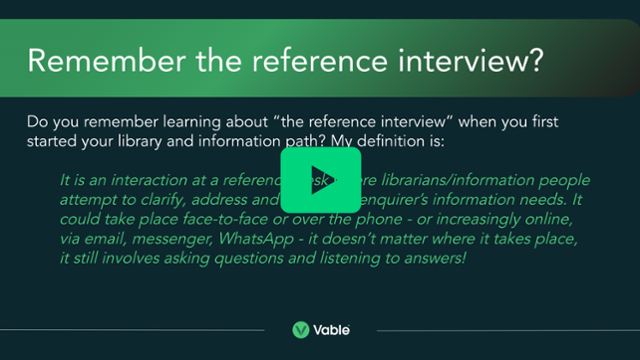Share this
What is library branding, and why is it important?
May 19, 2020

Branding is an important subset of marketing, which is a part of your library management skills toolkit. Your end-users, stakeholders, and clients want you to have a strong brand because they need you as their trusted advisor. Although it is intangible, branding adds value to your product/service because of the relationships it helps develop. Let’s explore further!
What is branding?
The Chartered Institute of Marketing defines the word 'brand as "the set of physical attributes of a product or service, together with the beliefs and expectations surrounding it - a unique combination which the name or logo of the product or service should evoke in the mind of the audience."
Philip Kotler and Gary Armstrong’s textbook on marketing says, "a brand is the name, term, sign, symbol, or design, or a combination of these, that identifies the maker or seller of a product or service." To this, I would add that a person, people, or team can become a brand, so this is why your end-users need to see and connect with YOU!
Branding is ubiquitous. Even supermarket value lines have recognisable branding. Therefore as Kotler and Armstrong point out, the practice of branding "is endowing products and services with the power of a brand." And because people are susceptible to emotion and suggestion, this power is enormous.
Why is library branding critical to success?
Brandingmag states that branding is critical because of the impact it makes on your organisation. Although I am talking about services within an organisation in this post, your own internal brand or outward ‘face’ has to be recognisable to your end-users. Customer awareness and increased visibility of your information service brand ensure familiarity, respect, and trust.
Library and information services not only need to establish this trust and build a reputation, but they need to demonstrate ROI. Visibility plays a large part in this, so when physical visibility - floor walking, reference desks, library signage - is impossible, you need to reinforce your brand visibility in other ways.
We already know that marketing is crucial in difficult times, and this is tied in with the effectiveness of your branding. You are aiming for 100% brand recognition amongst your end-users, clients, or audience. A recent article from HBR gives an overview of current branding challenges, as well as offering some practical advice to marketeers.
As people move beyond the current mode of survival, the momentum behind digital-experience adoption is unlikely to reverse as people are forced by circumstances to try new things. With so much changing so fast during this difficult time, what actions can brands take to serve and grow their customer base, mitigate risk, and take care of their people?
How to build a strong library brand
We have now established what branding is, and why it is so important. As that HBR article stressed, over the past few months, end-user behaviours have changed dramatically so it is time to take stock of everything - including your branding. Visibility of the library in both the online and physical environment is heavily reliant on the library having a strong, consistent brand.
Identifying and applying your brand
Do you have a brand specific to your library and information service? If so, is it instantly recognisable by your end-users? If no brand exists, consult your business development team and get some expert advice on how to go about applying corporate colours, logos etc. There may be strict rules about this and it’s always easier to build on an existing brand!
If your branding hasn’t been reviewed in awhile, is a library rebrand appropriate right now? That obviously depends on the availability of your current resources. A project like that needs stakeholder consultation and careful thought.
Previously I have written about maximising client engagement with newsletters and focused on the importance of content. However, that is only part of the story. Everything you are publishing, communicating, and pushing out for your audience’s consumption must have the ‘face’ of your service on it, and all internal and external content needs branding.
Stand out by branding your current awareness
A newsletter alert service like Vable ensures that your library and information service branding is automatically presented every time you send an email. We recognise its importance because it is one of the first questions the Vable team will ask you when you sign up for a free trial. “What branding do you want your newsletters to contain?”
It’s not just about colours and logos. Our clients are delivering aggregated content originally created by third-party publishers, but they are making it their own through expert annotation, editing and content selection. Given the sophisticated search functionality, even fully automated alerts are specific to your presentation requirements.
[Visually engaging content] shows that your brand is invested in providing value through communication, that you are considerate of your audience’s time and needs. … Your brand is more than a logo and tagline. It is a comprehensive identity that is communicated through every interaction
The branding element is what I am most interested in here. Make the content quickly accessible through a simple layout and then always brand your product - in this case, the alert you are sending to internal or external users. Let people know that you evaluated the content, made selections, and are monitoring it to build trust in your efficient and effective delivery.
When we say use your branding everywhere, we mean everywhere!
Even before you enter a physical space such as a shop, bank, restaurant, leisure centre, or airport you have been informed and influenced by branding. You have visited their website, followed them on social media, have downloaded their app. You may never go and visit them, but your interaction is very real. This is why a cohesive, comprehensive, commitment to your brand is essential in an online world.
Your library and information branding is not limited to the font on your shelf signage. Online visibility should be your priority so you must ensure that your logo and associated branding is prominently displayed. This will help them realise that all the online subscription services are made available to them, due to the ongoing hard work of the library.
Think about this carefully and create a list of all possible places where your service has a presence. For some library and information services your social media presence is your life-line; it’s how people recognise you and stay in touch. However for commercial, legal and other types of special collections, social media may not be appropriate.
You will have multiple ways of reaching your audience, which may include any (or all) of these:
- Company intranet
- Library website
- Library catalogue
- Library management system (LMS)
- LinkedIn etc page
- Internal communication systems such as Teams, Flowdock, Slack
- Online/subscription databases resource page
- Ticketing systems for query management
- Email signatures
- Regular email newsletters and current awareness alerts
- Forwarded emails
- Library report and research document templates
- Online tutorials, training
- Chatbots
- Blogs, guest blogs or journal articles
Your branding reassures your audience
Ultimately, the point of branding is to reassure your audience that they can depend on you and your service. To this end, you have to follow through on promises made to them that your service is first rate - you want positive associations with your brand, not negative! In a period of upheaval and change, such as recent events, seeing a familiar ‘face’ is reassuring.
For example, during the COVID-19 lockdown, I’ve found a couple of information communities that have reassured me. In my view, this has reinforced some positive brand associations.
- BIALL has hosted regular discussions about how COVID-19 has affected life and work. I have positive feelings of trust regarding the BIALL brand because of their conferences, which I know to be friendly. I have come out of these calls reassured, recognised, and feeling supported.
- #UKLibchat has also received extra recognition during this time. I have found their Twitter community discussions helpful, inclusive, empathic, and as selected comments are archived for future reference, it is a great resource. The people they select to host sessions are true brand ambassadors.
Other professional organisations, such as CILIP, ALA, SLA etc have also been running online events enabling members to connect in this time of social distancing.
Therefore the recognition and identification of your brand will provide reassurance to your end-users in many ways. They have found responsive and timely assistance, and quality resources and reliable information. Your brand will travel far beyond the constraints of your organisation, and will hopefully gain recognition in your organisation’s community of clients.
Branding and its positive associations is critical to you and your library and information service. It represents your face in the world, and will influence how your end-users perceive you and your service. Building a strong library brand means improved resources, increased influence, and a better outcome for your organisation.
Watch our new Vable Webinar Short about conversations between info pros and end users!
Share this
- January 2026 (1)
- December 2025 (2)
- November 2025 (2)
- October 2025 (3)
- September 2025 (2)
- August 2025 (2)
- July 2025 (4)
- June 2025 (3)
- May 2025 (2)
- April 2025 (1)
- March 2025 (1)
- October 2024 (1)
- July 2024 (1)
- June 2024 (2)
- May 2024 (2)
- April 2024 (3)
- March 2024 (3)
- February 2024 (4)
- January 2024 (2)
- December 2023 (1)
- November 2023 (2)
- October 2023 (2)
- September 2023 (1)
- August 2023 (3)
- July 2023 (5)
- June 2023 (2)
- May 2023 (2)
- April 2023 (4)
- March 2023 (1)
- February 2023 (1)
- January 2023 (2)
- November 2022 (2)
- September 2022 (2)
- August 2022 (2)
- July 2022 (1)
- June 2022 (1)
- May 2022 (2)
- April 2022 (3)
- March 2022 (1)
- February 2022 (2)
- December 2021 (2)
- November 2021 (2)
- October 2021 (2)
- September 2021 (2)
- August 2021 (2)
- July 2021 (2)
- June 2021 (2)
- May 2021 (1)
- April 2021 (2)
- March 2021 (1)
- February 2021 (3)
- January 2021 (2)
- November 2020 (3)
- October 2020 (1)
- August 2020 (2)
- July 2020 (4)
- June 2020 (1)
- May 2020 (1)
- April 2020 (2)
- March 2020 (2)
- February 2020 (3)
- January 2020 (1)
- December 2019 (2)
- November 2019 (1)
- October 2019 (1)
- September 2019 (1)
- August 2019 (3)
- July 2019 (3)
- June 2019 (3)
- May 2019 (2)
- April 2019 (1)
- March 2019 (2)
- February 2019 (3)
- January 2019 (3)
- December 2018 (1)
- November 2018 (2)
- October 2018 (2)
- September 2018 (1)
- August 2018 (2)
- July 2018 (1)
- June 2018 (2)
- May 2018 (3)
- April 2018 (3)
- March 2018 (1)
- February 2018 (3)
- January 2018 (1)
- November 2017 (1)
- October 2017 (1)
- July 2017 (1)
- April 2017 (2)
- March 2017 (3)
- February 2017 (1)
- January 2017 (1)
- November 2016 (2)
- October 2016 (1)
- September 2016 (1)
- August 2016 (2)
- June 2016 (1)
- May 2016 (1)
- April 2016 (1)


